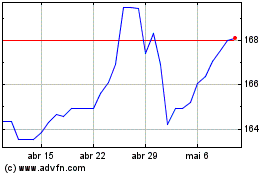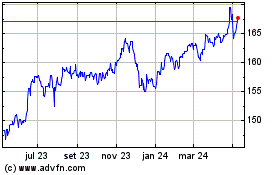Euro Climbs As Sentiment Improves On Receding Fed Rate Hike Hopes
06 Outubro 2015 - 5:08AM
RTTF2
The euro advanced against the other major currencies in European
deals on Tuesday, as risk sentiment improved in the wake of
disappointing U.S. non-manufacturing data for September, which
dampened expectations for the Federal Reserve rate hike this
year.
The Institute for Supply Management's non-manufacturing index
came in lower than expected to 56.9 in September from 59.0 in
August. Economists had expected the index to dip to 58.0.
Coupled with Friday's dismal jobs data, traders have pushed back
expectations for a Fed rate hike to next year.
Traders await the speech by European Central President Mario
Draghi in Frankfurt at 1:00 pm ET for more clues about bank's
stimulus measures.
In other economic news, data from Destatis showed that Germany's
factory orders declined in August as both domestic and foreign
demand deteriorated from July. Factory orders dropped 1.8 percent
month-on-month in August, confounding expectations for a 0.5
percent rise.
The euro trended lower against the greenback, yen and the pound
in the Asian session. Against the franc, the currency was
steady.
In European trades, the euro climbed to 1.1220 against the
greenback, off its early 4-day low of 1.1172. If the euro extends
rise, 1.13 is possibly seen as its next resistance level.
The 19-nation currency, having declined to a 4-day low of 134.40
against the Japanese yen at 2:00 am ET, bounced off to 135.03. The
next possible resistance for the euro-yen pair may be found around
the 136.00 region.
The single currency was trading higher at 0.7402 against the
pound, reversing from an early 4-day low of 0.7370. On the upside,
the euro may possibly locate resistance around the 0.75 area.
Data from Lloyds Banking Group's Halifax division showed that
U.K. house prices dropped unexpectedly in September.
House prices slid 0.9 percent month-on-month in September,
reversing August's 2.7 percent increase, which was the biggest
monthly growth in 15 months. Economists had forecast prices to gain
0.1 percent.
Rebounding from an early low of 1.0903 against the Swiss franc,
the euro edged up to 1.0940. The euro is seen finding resistance
surrounding the 1.10 level.
Switzerland's consumer prices dropped for the eleventh
consecutive month in September, logging the biggest annual decline
since 1959, according to a report from the Federal Statistical
Office.
Consumer prices fell 1.4 percent year-on-year in September, the
same rate of decline as seen in August. Economists had forecast
prices to drop 1.5 percent.
The euro recovered to 1.7320 against the kiwi, 1.4717 against
the loonie and 1.5802 against the aussie, from its early low of
1.7161, near 5-week low of 1.4607 and 2-week low of 1.5667,
respectively. Continuation of the euro's uptrend may take it to
resistance levels of around 1.75 against the kiwi, 1.48 against the
loonie and 1.60 against the aussie.
Looking ahead, U.S. and Canada trade balance data, both for
August and Canada Ivey PMI for September are set to be published in
the New York session.
At 5:30 pm ET, Federal Reserve Bank of San Francisco President
John Williams is expected to speak about the US economic outlook at
the Urban Land Institute's Fall Meeting in San Francisco.
Euro vs Yen (FX:EURJPY)
Gráfico Histórico de Câmbio
De Mar 2024 até Abr 2024

Euro vs Yen (FX:EURJPY)
Gráfico Histórico de Câmbio
De Abr 2023 até Abr 2024
